If you have a blog, you should also have a blog content calendar. Some sources refer to these outstanding planning aids as marketing calendars or editorial calendars. Yet whatever name they are known by, these calendar planners enable you to organize and keep updated on your posts.
They are essential for helping you concentrate on producing the ideal content for your target audience. With the regular use of a blog content planner, you can stay focused on writing. There is no need to waste time pondering what topics to write about next.
Start now by creating content calendar examples or maps and content calendar template google sheets of the blog content you will produce during 2020-21. Choose varied and balanced topic categories for best blog optimization. By planning ahead, you can brainstorm about great ways to take advantage of seasonal events and opportunities.
Once your blog calendar is completed, you can focus your full attention on writing. This is the very best way to attain your annual goals and grow your blogging site and business at a steady, productive rate. By following the map that your content calendar displays, you can increase your conversion rates and profits significantly as well.
Unless your blog is a pastime or hobby, you need to perceive it and treat it as a business. Since running a successful business requires planning, to plan your blog content with care and consistency makes perfect sense. Quality planning is an essential element of success in business, not an optional activity.
Reasons for Creating a Blog Content Calendar for 2020-21
Primary reasons for creating a comprehensive blog content planner for 2020-21 include the following:
- Planning is Motivating. By creating a detailed plan of your blog content for 2020 and 2021, you will gain enthusiasm for writing each successive blog post. The challenge of planning your content calendar examples will inspire and excite you about creating engaging content for each post.
- Creating Well-Planned Blog Content Engages Your Target Audience. With good planning, you will write content that your target audience desires to read. Otherwise, you may fall into the habit of writing on topics that interest and please you. If you and your audience have identical preferences, needs and tastes, this may work for you.
However, it is more likely that you may lose valuable readership by catering to your personal preferences. Unless you focus directly on writing content that is of high interest to your audience members, you may lose them. To interest and entice valuable existing and potential readers and site members or customers, create content that appeals to them.
- Enabling You To Attain Your Blogging Goals. You may be planning to launch a new product or service for your brand during the coming months. If so, you should write content that promotes the launch. You need to strengthen your credibility and visibility in your field. By creating curiosity and high interest about your new product or service, you can drive and build its sales conversion rates.
If your main intent is increasing profits from affiliate sales, your blog content must drive sales via your affiliate links. If your immediate goal is improving your blog site’s SEO, you need to create content and content calendar template google sheets with high quality keyword usage. Your blog must include cornerstone content relative to your major topics. In addition, your blog content categories must be well organized and balanced.
- Conserving Your Valuable Time. With a completed social media content calendar to work with, you can save valuable time. Your weekly focus of business activity can be directed to creating your planned blog content. You can avoid the unproductive need to “make up for lost time” due to poor planning. You will never produce less than the quality blog content needed by mistake or due to lack of prior organizing.
- Helping You To Concentrate on Quality Ideas. The majority of bloggers have a plethora of ideas to write about. Yet, in general, most of these will not be top quality ideas with highest relevance. By examining your ideas and using content calendar template google sheets to help you select the best ones, you will ensure that your blog will contain consistently high quality posts throughout the year.
- Ensuring Reaping the Benefits of Seasonal Opportunities. It can take some time for seasonal blog content to receive recognition and notice from Google and other search engines. For this reason, waiting until early December to write blog content for the winter holiday season is too late. Your holiday-related posts most likely will not be crawled by Google and be returned in searches until January.
Improve your content marketing + SEO in 60 seconds!
Diib uses the power of big data to help you quickly and easily increase your traffic and rankings. We’ll even let you know if you already deserve to rank higher for certain keywords.
- Easy-to-use automated SEO tool
- Get new content ideas and review existing content
- Checks for content localization
- SEO optimized content
- Built-in benchmarking and competitor analysis
- Over 500,000k global members
Used by over 500k companies and organizations:
Syncs with 
Important Points to Consider for Creating Your Blog Content Planner
Essential factors to keep in mind as you begin to plan your blog content for 2020-21 using content calendar examples include the following:
- Your Target Audience. Get to know your target audience well and understand what types of content interest them. What subjects do they relate to? What topics do they want to read about? Do they have specific issues and problems that you can shed light on or help resolve with your content? If so, you can gain avid readers by researching and creating content relative to these problems and their solutions.
- Your Blog Site Analytics. It is helpful to determine which of your posts are getting high readership and good Google rankings. You also need to take note of which ones are not. You should watch for any developing trends in post performance. By creating additional blog content that has similarities to your popular posts, you can increase your audience.
- Your Category Balances. To ensure top-quality SEO for your blog posts, you need to have good category balance. In other words, you need to have approximately equal numbers of posts in every category. Before planning more blog posts, examine your current category balances. If any categories have too many or too few posts, it is a good idea to work toward equalizing them.
- Your Goals and Seasonal Events. Consider your blogging objectives and goals. Determine what type, quality and quantity of content you need to attain them. Examine which seasonal events have the most impact on your blog. Decide what content concerning these events will be of greatest interest to your reader audience and target market.
Steps for Creating Your Blog Content Planner for 2020-21
Major steps for planning your blog post content calendar for 2020-21 are the following:
1. Set Your Number of Yearly Posts
Determine how many blog posts you need to write for the coming year. Of course, if you publish one post per week, you need to write 52 posts for 2021. Just multiply 52 by the number of posts you intend to create each week to get an accurate total.
If you plan to produce a new blog just twice a month, 26 posts will see you through the year. Many experienced bloggers pre-schedule posts to be published while they are on a trip or celebrating a holiday. Others simply take a week off from writing or posting blogs during major holidays and events. When looking at what days to post consider the image below, if the majority of users look at blogs on Mondays posting on a Sunday evening could help your posts rank higher.
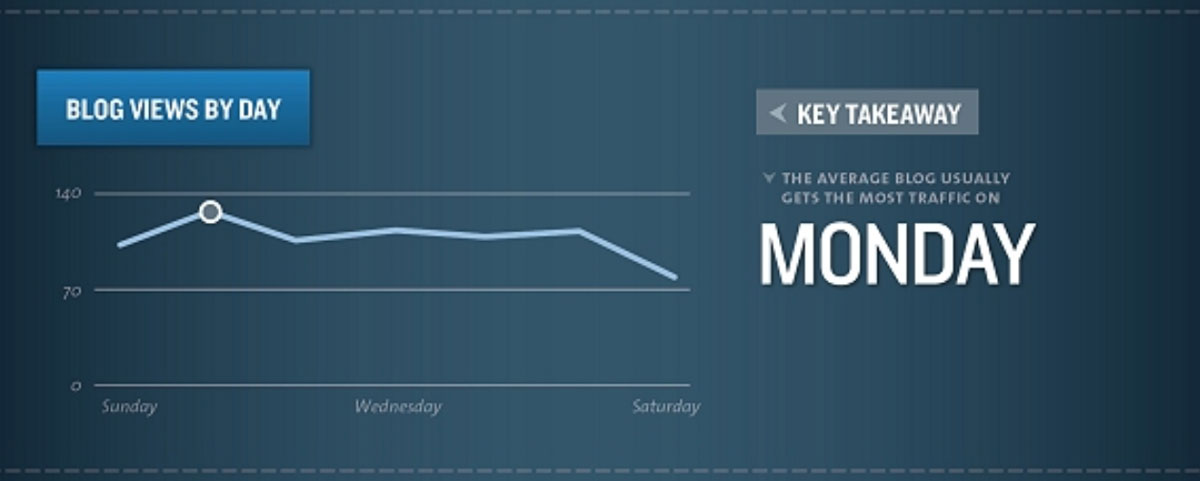
(Image Credit: CoSchedule Blog)
2. Design Your Blog Content Planner
When creating your post content calendar for 2021, it need not be complex or fancy. You can simply create a streamlined spreadsheet that displays this data. Include your projected post publishing dates, leaving space for inputting the post title beside the date.
Although this may seem too detailed and time-consuming, content calendar templates and examples are available online for your use. You can also locate instructions and tutorials on the web for producing your calendar. After creating one content planner, you can easily design new ones annually as needed. Here is a content calendar tool called Kapost that made it easy for this user to create their calendar:
You Might Also Like
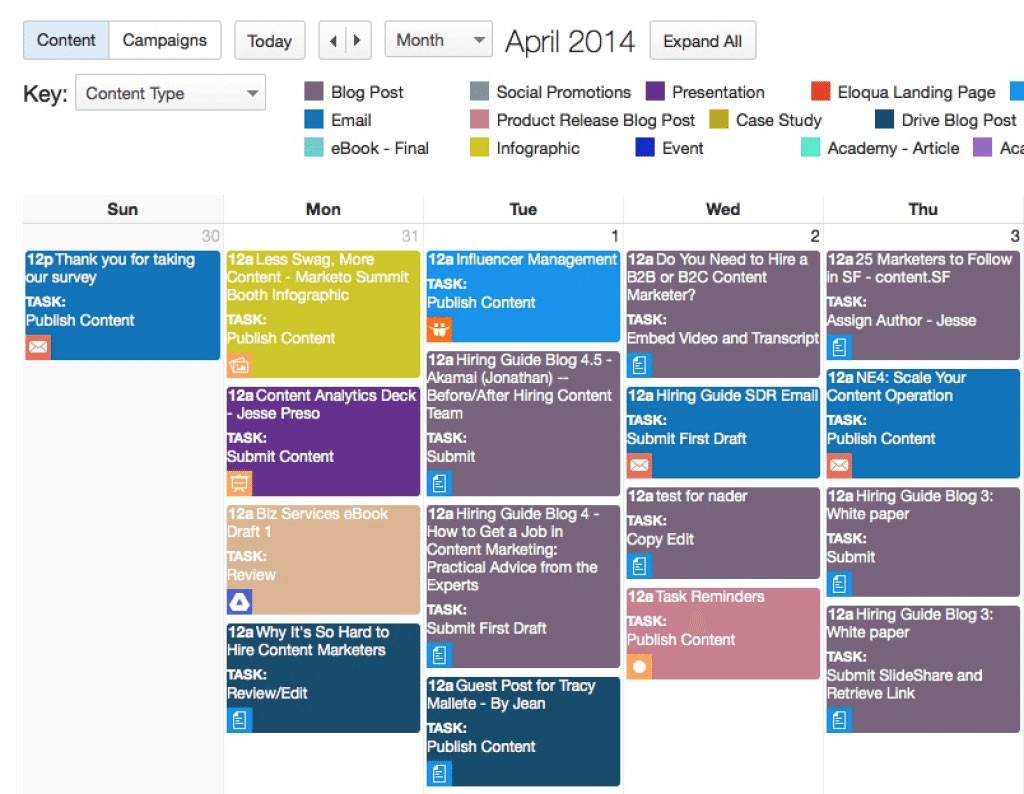
(Image Credit: Buffer)
3. Note Your Content Calendar Key Fixed Dates
On your blog content calendar 2021, mark the key fixed dates for which you need to plan post content. These dates can include all major holidays during the year along with some minor ones. You may want to note other special days as well, such as Valentine’s Day, Mother’s Day, Father’s Day or summer and winter solstice dates. There are templates for making content calendars that already have important holidays and other fun holidays in them. This way all you have to do is schedule your content around the holidays, for instance:
Product launch dates and related events are always important dates to note on your social media content calendar. New business project initiation dates, tax payment periods and special conference dates are also important to mark. If you produce posts in different categories at specific times of the month or year, you can note these dates also.
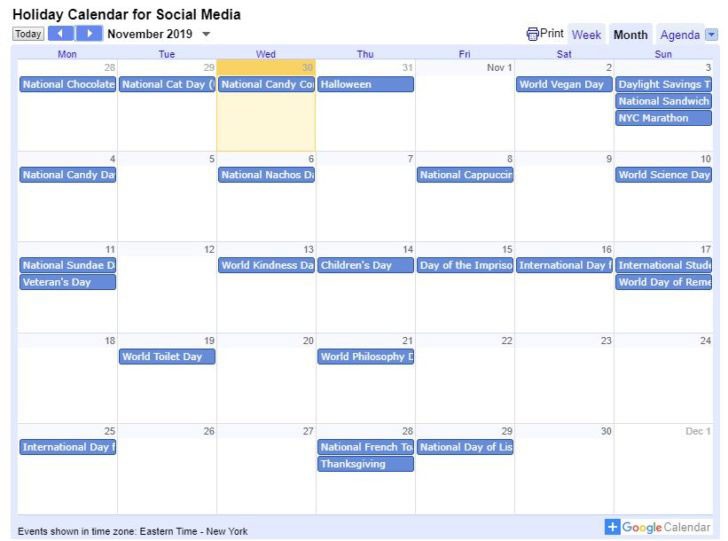
4. Plan Your Yearly Fixed Date or Seasonal Content
When you have fixed dates to include in your blog content planner as viewed in your content calendar app, enter this data first. Your other content will be scheduled around these dates. There is no need to be overly detailed at this point when entering your data since you can add specific information later.
Decide the number of blog posts that you want to produce for each fixed date or special event. For major holidays during the year, you may want to write three or four different posts. For your product launches and related events, you most likely will create several posts. Various seasonal events may call for multiple posts as well.
5. Make Calendar Entries for Other Important Content
You may have other important content for input on your blog calendar that lacks a fixed date. You may need to get word out about the future launch of a new project before setting the launch date. You can add these posts into your content calendar to make sure that they will be created and published. For instance:
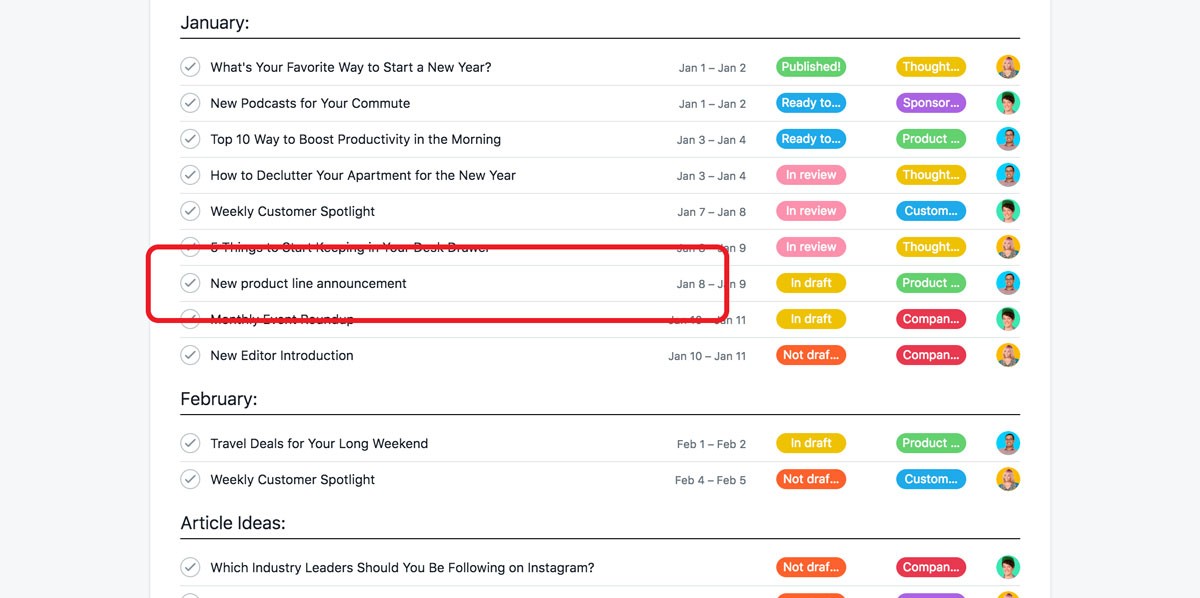
(Image Credit: Asana)
You may decide that you need to include more cornerstone posts for your four categories in your blog during the coming year. By including these future posts in your social media content calendar as viewed in your content calendar app, you can ensure that they will be produced in 2021. You can post this valuable content on the dates you choose for enhanced product launch promotion.
We hope that you found this article useful.
If you want to know more interesting about your site health, get personal recommendations and alerts, scan your website by Diib. It only takes 60 seconds.
6. Ensure That Your Categories Are Balanced
To ensure consistently effective SEO, keep a balanced number of blog posts scheduled for all of your blogging categories. If you have too few posts in one or more of your categories, you should balance the numbers. It is easy to accomplish this by adding new blogs for these categories into your 2021 blog content calendar template. If you section out your categories you can write out your blog post ideas under each category. Then you can see which categories are in need of more content. Afterwards, place the blog ideas where you want them to go in your calendar. Here’s an example:
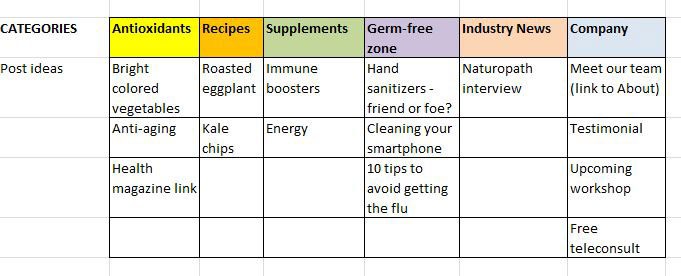
(Image Credit: Online Amplify)
7. Determine What Fresh Content You Need
If your blog concerns gardening, your categories may be vertical green wall gardening, succulent plants, flowering vines and exotic plant species. After checking your category balances, you may discover that ideal balancing requires producing different numbers of new posts for each category.
For example, to create this balance, you may need four more vertical green wall gardening posts. For the succulent plants category, you may need six more, for flowering vines, you may need five. You may discover that for the exotic plant species, you need seven additional posts. By scheduling and writing these posts, you can balance your categories during 2021.
8. Mastermind More Content
Jot down on notepaper the name of each content category for your blog. Second, add the number of posts that you need to create during 2020-21. Then use your powers of mastermind to devise ingenious ideas for post content under each category. Include ideas relative to your reading audience’s pain points or greatest interests.
Create ideas that have similarities to your most-read existing posts and ideas that are connected to your objectives and goals. Allow yourself five minutes to focus on each category. Then select the number of new ideas needed for each category, choosing only the best on your list.
9. Complete Entries in Your Content Calendar
Now you are ready to enter the ideas for all of your blog posts for the coming year in your content planner. Arrange your post ideas in logical and engaging order. You want to supply your audience with a wide array of content every week.
It may require some time to arrange your content ideas in an order that you find satisfactory. Yet once you do, you will have planned your post content for all of 2021. If you color code your spreadsheet, you can easily distinguish each topic and its category and note the key dates or events. For example:
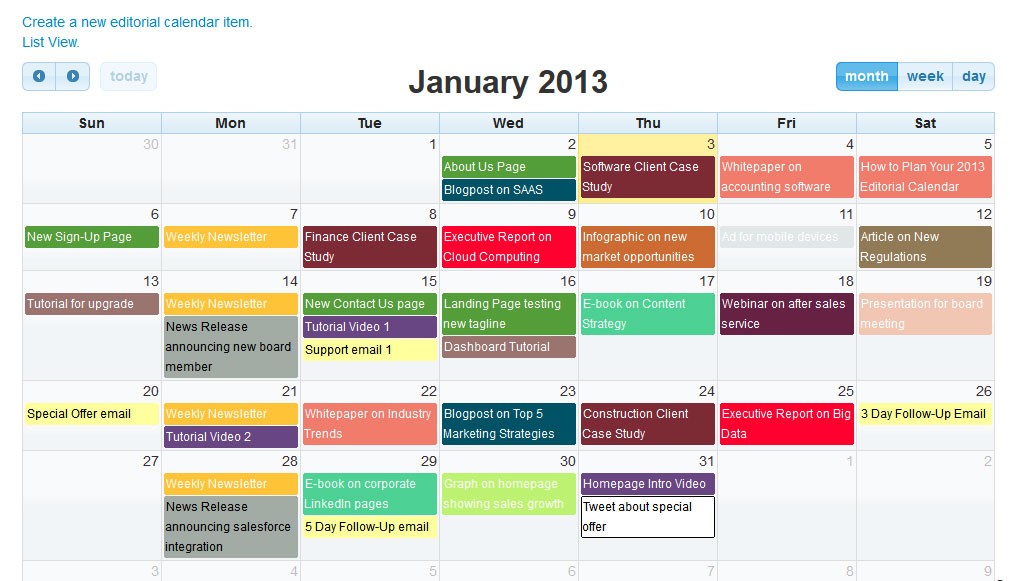
(Image Credit: Walsworth)
10. Make Good Use of Your Content Creation Calendar
With your blog post topics planned and clearly noted on your blog content calendar template for the year, you will be more at ease and focused when you write posts. You will have no need to be concerned about what subject to blog about next. With the creation of each new post, you can strengthen your blogging persona, credibility and readership.
Remember that your content planner is never set in stone. You may revise an idea or get a sudden inspiration to write about another subject. You may also receive an opportunity to produce a sponsored post. You can always reschedule posts and arrange your calendar accordingly.
Your Blog Content Planner is Never a Writer’s Restriction
Always remember that your completed blog post calendar is a fluid blueprint for the year ahead. It is meant to simply keep your content production organized and moving smoothly. It is also meant to help you avoid the extra stress of having to create new content ideas quickly, without time for brainstorming or reflection.
Some bloggers are apprehensive about using content planning for producing well-organized category posts. They fear that working with a scheduled output calendar for creating posts will restrict their thought processes and creativity.
Think of your post calendar as viewed on your content calendar app as the first draft of a book chapter to be revised, improved, streamlined or embellished. You can make additions and changes as desired and needed. You are likely to find that your post planner is both the originating source and reference source for your yearly posts.
Diib®: Keep Track of Your Blog Success Here!
A content calendar for your blog post content is an innovative and effective tool for planning and organizing yearly posts. Rather than restricting your blogging creativity and output, it can be a concise and productive guide for producing engaging posts. Flexible and open to change, your calendar can enable you to choose category topics wisely while staying available to unexpected opportunities.
Diib Digital gives you the unique opportunity to view statistics and different metrics regarding your blog campaigns. Some of the features of our User Dashboard our clients report finding especially helpful:
- Keyword, backlink, and indexing monitoring and tracking tools
- Google Core Algorithm monitoring
- Blog campaign monitoring and tracking
- Alerts to broken pages where you have backlinks (404 checker)
- Alerts and Objective that guide you to strengthen your website
- Monthly call with a growth expert
Click here for your free 60 second site analysis and industry ranking or call 800-303-3510 to speak with one of our Growth Experts
FAQ’s
A content calendar could include: places you publish your content (social media, blog, another website, forum ect.), topics you choose to write about, scheduled promotions and ideas for upcoming content.
A content strategy plan is the process of planning, creation, delivery and responsibilities. This ensures you have a readable and useful site, with regularly posted quality content.
The first and most important tool you can have is to learn how to tell a story. This is essential for any great blog post. Next, use active verbs and catchy openings. Use language that is simple and easy to read. Share your writing and ask for critiques.
Content marketing is the strategic approach to creating and distributing valuable, relevant and consistent content in order to attract a specific audience. Which will, eventually, drive traffic.
A blog is still a very relevant and powerful tool to establish yourself as an expert in your field, AND helps to drive traffic to your site.



